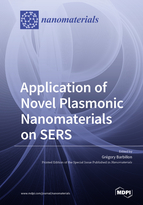Application of Novel Plasmonic Nanomaterials on SERS
A special issue of Nanomaterials (ISSN 2079-4991). This special issue belongs to the section "Nanophotonics Materials and Devices".
Deadline for manuscript submissions: closed (30 September 2020) | Viewed by 23445
Special Issue Editor
Interests: plasmonics; nano-optics; non-linear optics; nanophotonics; condensed matter physics; optical sensing; biosensing; nanotechnology; surface-enhanced spectroscopies; sum-frequency generation spectroscopy; materials chemistry; physical chemistry; fluorescence
Special Issues, Collections and Topics in MDPI journals
Special Issue Information
Dear Colleagues,
Surface-enhanced Raman scattering (SERS) is a topic of research that was discovered in the mid-1970s. However, it is in this last decade that a very significant explosion of the fabrication of highly sensitive SERS substrates has occurred using novel designs of plasmonic nanostructures (e.g., nanoparticle self-assembly), and new plasmonic materials, such as bimetallic nanomaterials (e.g., Au/Ag) and hybrid nanomaterials (e.g., Metal/Semiconductor) have been fabricated via different physical or chemical techniques. These novel plasmonic nanomaterials can allow a better confinement of the electric field and thus induce an enhancement of the SERS signal (electromagnetic contribution) by adjusting, for instance, the size, shape, periodicity, nanoparticle self-assembly, and nanomaterials’ nature. These nanomaterials can also enhance the charge transfer (electrons; chemical contribution) to increase the SERS signal. Thus, this Special Issue is dedicated to introducing recent advances and insights in these novel plasmonic nanomaterials applied to the fabrication of highly sensitive SERS substrates for chemical and biological sensing. Therefore, it is with great pleasure that I invite you to submit a manuscript for this Special Issue. Full papers, communications, and reviews are all welcome.
Prof. Dr. Grégory Barbillon
Guest Editor
Manuscript Submission Information
Manuscripts should be submitted online at www.mdpi.com by registering and logging in to this website. Once you are registered, click here to go to the submission form. Manuscripts can be submitted until the deadline. All submissions that pass pre-check are peer-reviewed. Accepted papers will be published continuously in the journal (as soon as accepted) and will be listed together on the special issue website. Research articles, review articles as well as short communications are invited. For planned papers, a title and short abstract (about 100 words) can be sent to the Editorial Office for announcement on this website.
Submitted manuscripts should not have been published previously, nor be under consideration for publication elsewhere (except conference proceedings papers). All manuscripts are thoroughly refereed through a single-blind peer-review process. A guide for authors and other relevant information for submission of manuscripts is available on the Instructions for Authors page. Nanomaterials is an international peer-reviewed open access semimonthly journal published by MDPI.
Please visit the Instructions for Authors page before submitting a manuscript. The Article Processing Charge (APC) for publication in this open access journal is 2900 CHF (Swiss Francs). Submitted papers should be well formatted and use good English. Authors may use MDPI's English editing service prior to publication or during author revisions.
Keywords
- SERS
- bimetallic nanomaterials
- hybrid nanomaterials
- plasmonics
- novel plasmonic nanomaterials
- nanoparticle self-assembly
- sensing







